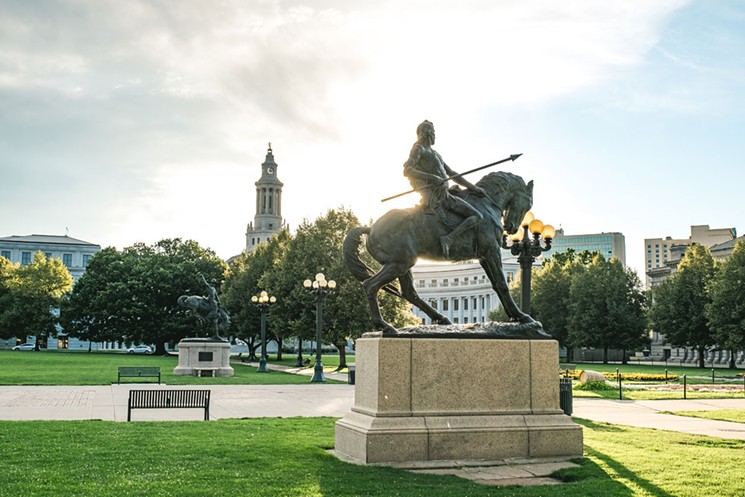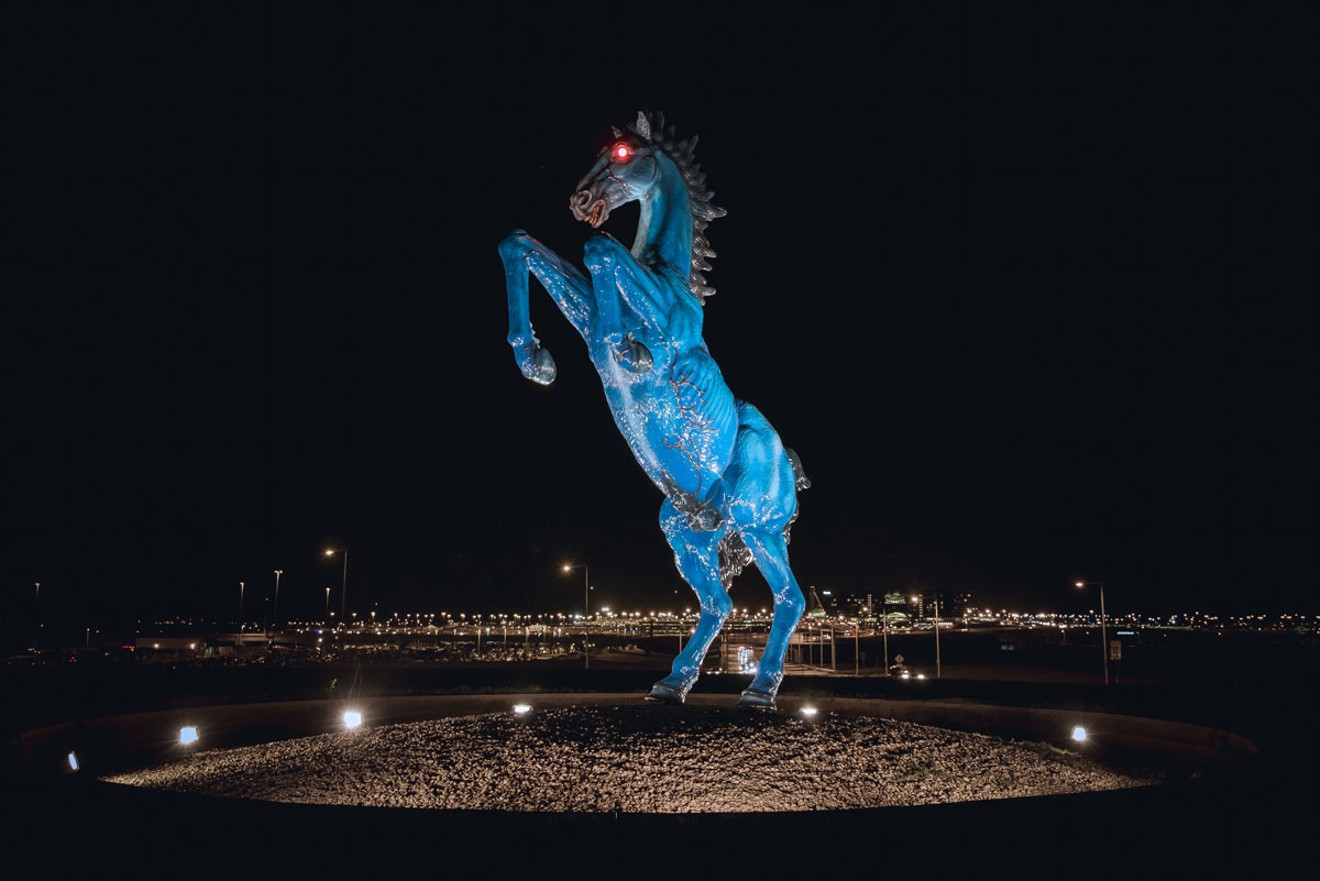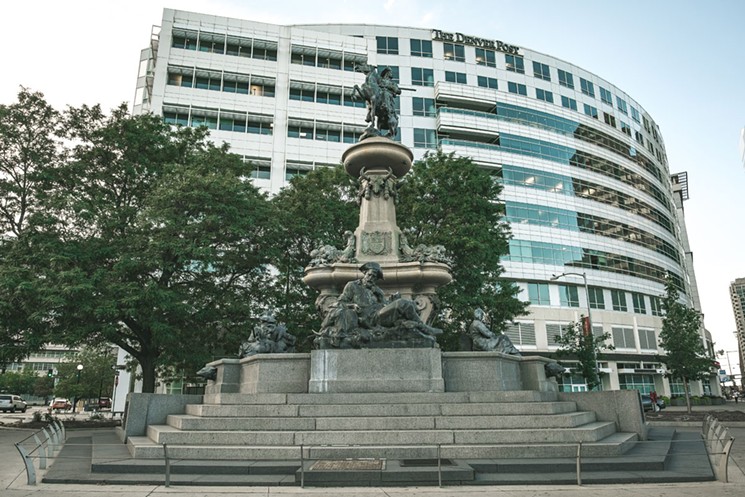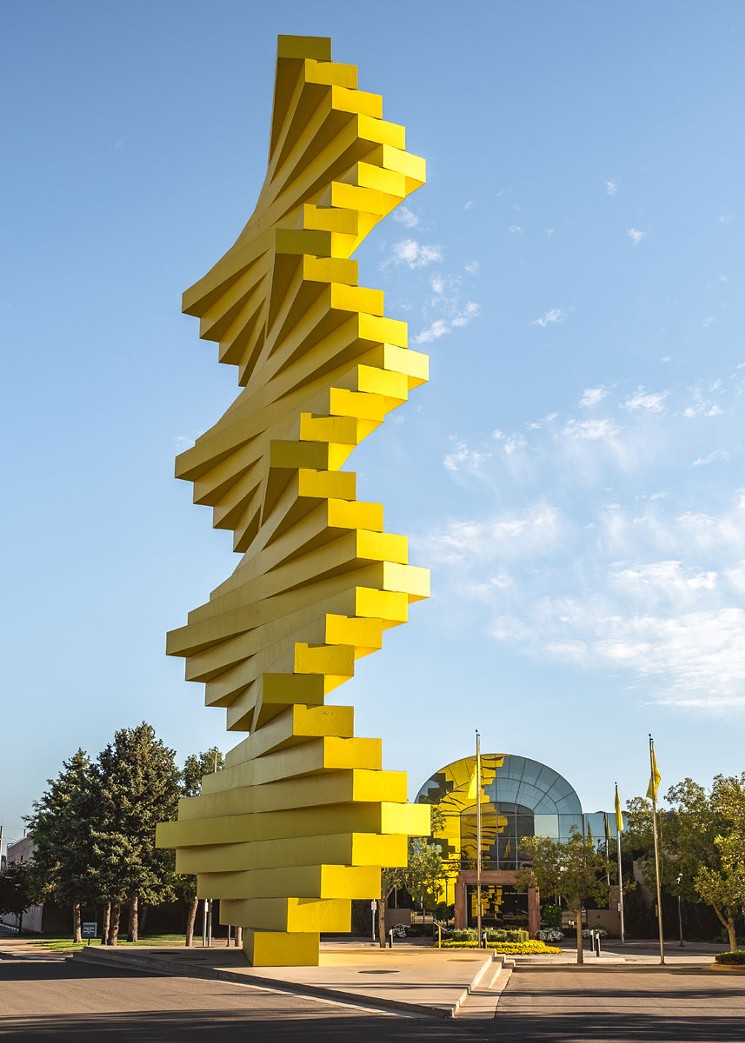Then in 1988, Mayor Federico Peña issued an executive order creating a program to fund and collect public art in Denver. His successor, Wellington Webb, made it official, establishing the Mayor’s Office of Art, Culture and Film (now Denver Arts & Venues) and requiring a 1 percent set-aside for public art on all city-funded construction projects costing $1 million or more. In 1994, RTD got into the act with its Art-n-Transit program, which commissions artwork to embellish bus and rail stations. The State of Colorado and the federal government also funded art acquisitions. And, of course, from the founding of this city, many private donors have contributed to the cause of art in very public places.
In most cases, those private efforts have resulted in far better pieces. Almost invariably, the works selected through the public process are disappointing to dismal, since selection juries are dominated by those with the political connections needed to be appointed, but lacking the art expertise necessary to make good choices. There are a few happy exceptions, though, including the three publicly funded pieces that made this list of the best outdoor sculptures in Denver.
Still, while the quantity of public sculpture in this city may be lacking, there’s no shortage of quality — at least, not in these top ten examples, presented in chronological order.
“Pioneer Fountain”
Frederick MacMonnies, 1911
Broadway and Colfax Avenue
“Pioneer Fountain,” an exuberant, Beaux Arts, neo-classical-style bronze-and-granite wedding cake adorned with Old West characters, is the perfect sculptural expression of Denver’s place as the capital of the Western frontier. But as great as it is to have this piece in the heart of Denver today, the whole experience must have been very bittersweet for its creator, Frederick MacMonnies, an internationally renowned sculptor who was born in Brooklyn Heights and studied and worked in Paris.
Shortly after the turn of the last century, Mayor Robert Speer was interested in the beautification of Denver, and one of the things he wanted to do was establish a civic center in the form of a park around which public buildings could be constructed, located somewhere west of the Colorado State Capitol. MacMonnies was among those who submitted a proposal for the project; his plan called for a park that would run from the front steps of the Capitol toward downtown, ending at the Arapahoe County Courthouse, which stood at Court Place and 15th Street; midway between these two structures would be his fountain, surrounded by a park.
MacMonnies did not get the job of designing Civic Center Park — Charles Mulford Robinson did — and his plan didn’t get built, either, but that’s another story. And while MacMonnies did get a commission to create a fountain, without his plan it wound up in a rather oddball location at Broadway and Colfax. Not only that, but public pressure during the design phase forced him to change the principal figure he’d wanted to place at the top of the fountain. MacMonnies’s original model was surmounted by an Indian on horseback — but in the fountain as realized, it’s a figure of Kit Carson astride his horse and holding his rifle in one arm, using the other to point to the mountains.
Talk about your Western Americana!
“Thatcher Memorial Fountain”
Lorado Taft, 1918
City Park Esplanade off East 17th Avenue
The “Thatcher Memorial Fountain” lacks the theatricality of the “Pioneer Fountain” and has no Wild West allusions at all. Then again, Joseph Addison Thatcher, the man who commissioned the sculpture, was a wealthy, successful banker, not a romantic frontier figure. And he spared no expense when choosing the sculptor: Lorado Taft, a Chicago-based, Paris-trained artist in the top ranks of his day. Taft wasn’t just noteworthy for his talent; early on, he’d encouraged women to become sculptors. Back in 1892, architect Daniel Burnham had become concerned that Taft would not be able to complete sculptures commissioned for the World’s Columbian Exposition in Chicago in time for its opening in 1893. Taft responded that he could meet the deadline if his female assistants helped with the task — a fairly outrageous request in those days — and Burnham was persuaded to take a step toward gender equality, if only because of the urgency of the project.
At the top of the “Thatcher Memorial Fountain” he created 25 years later, Taft placed the personification of Colorado: an older woman in robes. The base of the fountain is divided into three parts, representing “Loyalty,” “Love” and “Learning”; each part features three figures. The central figures in these groups are depicted in full length, with those on either side conveyed as three-quarter busts, creating three T- shaped compositions enhanced by the horizontal, decorative banding that runs below. This banding also appears on the main pedestal on which the Colorado figure stands, where it is punctuated by shield medallions. Though the figures on the fountain are rendered traditionally, there’s definitely a proto-modernist quality to the overall design. With those T shapes and that banding, it looks like an exemplar of nothing other than the Viennese Secession — right here in the Mile High City.

“Bronco Buster” (background) and “On the War Trail” (foreground), by Alexander Phimister Proctor.
Marvin Anani
Alexander Phimister Proctor, 1920/1922
Civic Center Park
Back at the Civic Center, Western-themed sculpture still ruled the range in the form of “Bronco Buster,” a cowboy on a bucking bronco, and the companion “On the War Trail,” with an Indian riding a stallion. Though they are individual pieces, flanking either side of the walkway leading to the Greek Theater, they’ve come to be seen as an inseparable pair.
The artist who created both of these sculptures, Alexander Phimister Proctor, was born in Canada, grew up in Denver, then enjoyed a successful career that took him to New York, Paris and back to New York before he finally settled in Oregon, where these pieces were made. Proctor was renowned for his depictions of animals, and the horses here — one bucking, one striding — are exquisitely done. The human figures are well done, too, and come with interesting back stories. “Slim” Bill Ridings, the model for the cowboy in 1920’s “Bronco Buster” — originally “Broncho Buster,” reflecting the preferred spelling at the time — was arrested for horse theft while Proctor was working on the piece, and the artist paid his bail so that the sculpture could be finished. And while “On the War Trail” was created only a decade after “Pioneer Fountain,” the public conception of Native Americans had changed notably by 1922. Instead of representing Denver’s original inhabitants as some kind of enemy, the passage of time had transformed the popular view of the Indian into nothing less than a romantic hero — just like the cowboy.
Unlike the earlier realist pieces by MacMonnies and Taft, these sculptures by Proctor are more impressionistic, their details smoothed over without losing any sense of their being realistic. Like “Pioneer Fountain,” though, they help to identify Denver as a Western city.
Burns Park Sculpture Garden
Various artists, 1968
Between Colorado Boulevard, Alameda Avenue and Leetsdale Drive
Though a few mid-sized sculptures appeared in Denver from the 1930s through the mid-1960s, none had the monumentality of earlier pieces. This changed in 1968, though, when a motley band of mostly regional artists erected a set of gigantic, minimalist plywood sculptures on a weed-strewn triangle of land at the west end of Hilltop, right off Colorado Boulevard.
It all started with a Thanksgiving-night visit to the home of University of Denver art professor Bev Rosen and her husband, Bernie Rosen, by Denver sculptors Roger Kotoske and Wilbert Verhelst. Kotoske complained that there was no place in town to exhibit sculpture, and Bev came up with the idea of a sculpture garden — a new concept for anywhere at the time, let alone in the sculpture desert that was Denver. Bernie used his influence to secure the land (not yet dubbed “Burns Park”) for the first and only Denver Sculpture Symposium in the summer of 1968. At that time, nine pieces were erected; in addition to works by Kotoske and Verhelst, there were sculptures by Anthony Magar, Dean Fleming, Peter Forakis, Robert Morris, Robert Mangold, Richard Van Buren and Angelo Di Benedetto. The sculptures were only meant to be up for that summer, a condition that Bernie agreed to in exchange for the use of the land.
While three sculptures were indeed removed at the end of that summer and two more were destroyed over the years, the Burns Park Sculpture Garden remains. The original Kotoske, Verhelst, Magar and Di Benedetto are still there, and two more pieces have been added: another Magar created at the time of the symposium, and a much later Barbara Baer. Aside from the too-new Baer, together these sculptures present a snapshot of the most advanced aesthetic currents of the 1960s.
“Soft Landing”
Kenneth Snelson, 1982
17th Street Plaza, 1225 17th Street
The face of Denver changed in the 1970s and ’80s, when some of the most important architects in the world — Gio Ponti, Minoru Yamasaki, Skidmore Owings Merrill (SOM), Kohn Pedersen Fox (KPF) and Phillip Johnson among them — created buildings downtown. This glorious era ended ignobly with the oil bust of the ’80s and, sad to say, the aesthetic and stylistic quality of Denver’s architecture has never recovered, with the exception of a stray notable building rising up here or there. Though some monumental sculptures accompanied these glamorous high-rises, most have been removed, including the monumental Harry Bertoia “Untitled (Sonambient)” that once stood in front of Yamasaki’s former Colorado National Bank tower. That makes the fabulous “Soft Landing,” one of Kenneth Snelson’s most significant commissions, a rare survivor from a list that was short to begin with.
Snelson’s oeuvre was dominated by his interest in manipulating the properties of physics and the concepts of three-dimensional mathematics to create his nominally minimalist pieces. As a summer student at Black Mountain College in the late 1940s, he’d become enamored with the contraction of engineering and aesthetics in the work of Buckminster Fuller; he went on to build models for the vanguard engineer and theoretician and they developed a close relationship, though they later had a falling out. Snelson’s breakthrough commission was for a gigantic suspension piece at the New York World’s Fair of 1964 and 1965.
Though Snelson created a range of forms, “Soft Landing” is one of his signature pieces, in which hollow tubes and steel cables are used to express an elaborate shape suspended in the air, an effect the artist called “floating compression.” And looking at this piece in Denver, you can definitely see what he meant.
Keep reading for more of Denver's best outdoor sculpture.
“articulated wall”
Herbert Bayer, 1985
Denver Design Center, 595 South Broadway
In the 1980s, the Merchants Park Shopping Center came down, only to be replaced by the Denver Design Center. This ambitious development housed a raft of high-end wholesalers, adjacent to a high-end retail complex; there was even a Revillon Fur shop and a Le Printemps department store — on South Broadway! But as with just about everything else that went up during the oil boom, it went under with the oil bust. The high point of this project was the erection of Herbert Bayer’s “articulated wall,” a staggering (and staggered) 85-foot-tall tower, painted canary yellow and made of concrete bars stacked one on top of another, anchored by a hidden steel mast through the center.
Bayer is one of the most important artists to have lived and worked in Colorado. Both a student and a teacher at the Bauhaus, a famous German art school, he fled the Nazis and eventually settled in Aspen in 1946; he lived there until 1976. Bayer was ill and infirm when his “articulated wall” was installed in 1985, and he died later that year. But he had been working on similar forms for many years, and had overseen the creation of a comparable if shorter version for the Mexico City Olympics in 1968; before that, he’d proposed creating iterations of these undulating walls as a way to “beautify” oil-storage facilities.
Denver’s towering “articulated wall,” owned by the Denver Art Museum, can be easily viewed from Broadway, with even better (if fleeting) vantage points from I-25 and light rail. This fits with Bayer’s intention for sculptures of this type: that they should be seen from a distance through the windows of cars and trains. He also wanted them to be experienced up close by pedestrians, but most disappeared along with the Denver Design Center’s retail stores.
“Lao Tzu”
Mark di Suvero, 1996
Acoma Plaza at West 13th Avenue
Mark di Suvero is the most famous and important artist on this list, and his stunning “Lao Tzu” is the finest outdoor sculpture in Denver. He created the piece in 1991 in his factory-sized New York studio, but it did not arrive in Denver until five years later. “Lao Tzu” is a classic di Suvero: a bold, non-objective “drawing in space,” with structural steel beams standing in for penciled lines and the entire piece finished uniformly in an equally bold shade.
The late Nancy Tieken, one of the city’s great art patrons, is responsible for “Lao Tzu” landing in Denver. Tieken had seen the piece at di Suvero’s place and decided to pledge $500,000 toward its purchase and installation; the Denver Art Museum picked up the remaining $300,000. But there were initial issues with the site, which di Suvero himself had chosen. The powers-that-be at the DAM wanted the sculpture closer to West 14th Avenue, while the Denver Landmark Commission was concerned that the gigantic, reddish-orange abstract sculpture was incompatible with the neutral shades of the neo-classical monuments in the Civic Center. But it turns out that di Suvero, a seasoned veteran in the field of monumental outdoor sculpture, was right: “Lao Tzu” was perfectly sited to serve as the gateway to all that was to come during the next twenty years.
When the di Suvero was placed in this spot, there were only parking lots and an occasional run-down building to the south; now there’s the DAM’s Hamilton wing flanked by the Museum Residences. One of the city’s great views today is looking north from the Martin Plaza at West 12th Avenue toward the di Suvero, with the Greek Theater rising up beyond it and downtown’s skyscrapers providing the perfect backdrop.
“Indeterminate Line”
Bernar Venet, 2004
Colorado Convention Center at Speer Boulevard
The Colorado Convention Center has a carefully curated art collection, which is not what you’d expect in a venue used for industry meetings, trade shows and displays of cars, garden supplies or boats, depending on the season. One of the best pieces, inside or out, is Bernar Venet’s “Indeterminate Line” — which, come to think of it, is one of the finest sculptures anywhere in the state.
Venet, whose career stretches back to the 1960s, was already a famous French artist when he first visited New York; he relocated permanently to the Big Apple in 1997. By then, he’d been working on the “Indeterminate Line” series — essentially three-dimensional scribbles — for a number of years. His Colorado Convention Center piece was made in Hungary out of self-sealing Cor-Ten steel; the twenty-ton sculpture was cut up into dozens of pieces so that it could be shipped. Accompanied by a crew of Hungarian metal workers, it was reassembled here in Denver and sandblasted to create an even finish of rust on its many surfaces. Although most of the Hungarians spoke no English and no one on the team from Denver’s Juno Works — which was charged with the sculpture’s construction — could speak Hungarian, somehow it all came back together like an enormous puzzle.
The result is a tight squiggle of rusting steel balanced on a single diagonal “leg” that terminates in a candy-cane hook. The sculpture’s curly form has given rise to the vulgar nickname “The Pube,” to which I say, “Laugh, clowns, laugh.” Because “Indeterminate Line” is a masterpiece.
“I See What You Mean”
Lawrence Argent, 2005
Colorado Convention Center, 14th Street
The forty-foot-tall Big Blue Bear, officially named “I See What You Mean,” may be the most popular piece of art in Denver. Lawrence Argent’s sculpture has been reproduced as statuettes, appropriated by the Scientific and Cultural Facilities District for its campaigns, and frequently seen in B-roll shots of the city aired during televised sports coverage. Both the popular and critical success of the work reflect how effectively Argent, a local artist, resolved various factors. He considered the function of the Colorado Convention Center, a destination largely for people who don’t live in Denver, and decided that his piece should convey the idea of “Colorado” in the popular imagination of those who aren’t from this state. So he came up with the idea of referencing the Rockies because at the time, the mountains were what people thought of when they thought about Colorado. (Needless to say, this was before the legalization of pot.)
“I See What You Mean” is an example of trans-media — in this case, a digitally-based sculpture. Using computer files and 3-D printers, Argent made a model that abstracted the form of a bear, simplifying its shape by creating its contours out of a multiplicity of stacked and intersecting planes standing in for fur. The final sculpture comprises a hidden steel armature covered in blue fiberglass concrete panels. Complicated technology aside, Argent designed the bear and set it so that it appears to be peering through the windows of the center to see what’s inside — an inspired advertisement for the attractions in the place. But it’s brilliant on its own: decidedly whimsical, yet also extremely sophisticated, both conceptually and visually.
“Mustang”
Luis Jiménez, 2008
Jeppesen Terminal, Denver International Airport
If I live to be a thousand, I don’t think I’ll ever understand how the Big Blue Bear could instantly become a beloved landmark for an entire community while Luis Jiménez’s Big Blue Horse immediately became an object of ridicule, so much so that a petition was launched demanding the removal of what’s commonly become known as Blucifer but is officially called “Mustang.” There’s just so much that links the bear to the horse, beyond both being blue. For starters, in each piece, a narrative-rich animal is used to refer to Denver’s Western heritage; in addition, both are intelligently conceived and perfectly carried out.
If I had to come up with a theory for why one was quickly loved and the other loathed, I’d suggest that the combination of the stress of air travel and the horse’s wild expression, accented by those orange lights used for its eyes, did not make it easy for some to warm up to “Mustang.” Nor did the fact that post-911, the envisioned park that was supposed to surround the sculpture never materialized. But maybe people simply hate “Mustang” because the sculpture is cursed. The piece was supposed to be completed by DIA’s opening in 1995 but didn’t arrive until 2008. In the meantime, there were crisscrossing lawsuits from the city and Jiménez, both claiming breach of contract; since this was the tallest sculpture that Jiménez had ever created, it posed technical problems that he needed to painstakingly solve, and that was the cause of much of the delay. And then, while he was still finishing the piece in 2006, a part of it — the enormous head with its fearsome features — fell and killed the artist. “Mustang” was ultimately completed by his assistants.
Cursed or not, “Mustang” ranks as one of the greatest works of art in the region.




















